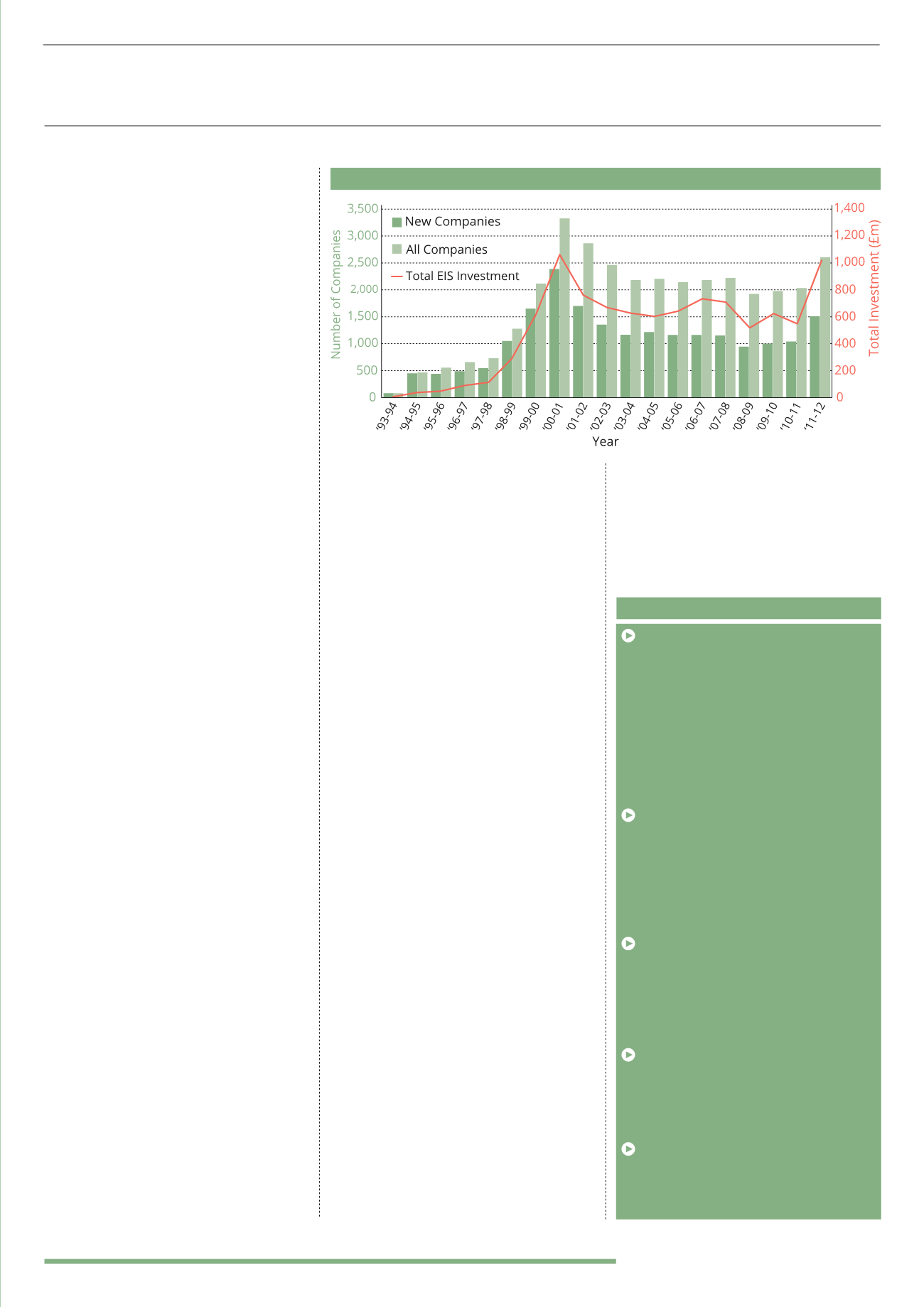
11
GROWTH OF MARKET
The chart opposite shows how both the
total amount of funds raised into EIS and
the number of companies raising capital
increased steadily from 1994 to 1998 and
then sharply from 1998 to 2001, in line
with the ‘tech’ boom in the stock market.
Both the amount of investment and
the number of companies raising
funds via EIS fell after 2001.
We can speculate that the tech boom in the
late nineties attracted a lot of investment
into smaller, start-up style firms and that
encouraged investment into EIS qualifying
companies. After 2001, the stock market
rallied and a strong bull market existed
until 2008 – but this market was not
associated with smaller companies in the
same way as the previous bull market was
and, consequently, we did not witness
dramatic increases in EIS fundraising.
This is actually encouraging, as it shows
that the EIS market is at least somewhat
uncorrelated from mainstream markets – at
least when it comes to fundraising success.
What is also encouraging is that after an
initial dip of companies raising funds via EIS,
from 2004 – 2011 the numbers have stayed
reasonably steady, indicating that there is
a strong foundation of engaged investors
and successful fundraisers in the market.
In the 2011/12 tax year, there was a dramatic
spike in both the amount of funds raised
(an increase of 87% to £1.017bn) and the
number of companies raising money
(including a large influx of new companies
accounting for 41% of the total).
This sharp increase can be attributed to
the increase in Income Tax relief from 20%
to 30% in 2011, historically low interest
rates and the introduction of the 50%
Income Tax rate for higher earners (over
£150,000 and since reduced to 45% again).
We can also speculate that the introduction
of Feed-In Tariffs (FITs) in 2010, stimulating
investment into renewable energy, also
played a part. The combination of the
security of revenue that FITs provide
combined with a low-risk asset backed
investment in a tax efficient EIS was very
alluring. Companies benefiting from FITs
were excluded from EIS qualification in 2011,
and Renewable Obligation Certificates,
which provide similar benefits, were
excluded in the recent 2014 budget.
The announcement in December 2012 that
the government would be reducing the
annual allowance for pension tax relieved
savings from £50,000 to £40,000 and the
lifetime allowance from £1.5m to £1.25m
may have a similar positive impact on
funds raised into EIS over the next few
years. We may well see EIS investment
used as a form of ‘pension substitution’.
Most investments are still relatively small
– 49% of investments are below £100,000
and funds are typically raised from a
number of smaller investors investing
£10,000 – £30,000. Many investors
will invest relatively small amounts
– perhaps £10,000 – but invest these
amounts regularly, perhaps every year.
However, 50% of the amount of funds raised
into investments is over £1m. Over 60% of
the companies raising money via the EIS are
in London and the South East (although this
does not necessarily mean that is where
all of their activity is based, this statistic
is taken from the companies registered
address). What is also interesting to note
is that, as of 2012, over 70% of investment
goes into three categories: Other Services
(recreational, medical and educational),
High Tech and Business Services.
In total, the Enterprise Investment
Scheme has promoted investment of over
£11bn since it started. Although there
are no official figures to support this, it
has been suggested that the Treasury
earns more in tax from the success of
the companies supported by the EIS than
they give away in relief to investors, and
the government and politicians from all
the major parties are, of course, keen to
support the important SME (Small and
Medium-sized Enterprises) sector.
As Matt Taylor of Rockpool put it at our 2013
Alternative Investment Summit in London:
“You can judge political support by politicians’
willingness to be photographed in connection
with the EIS. It does not seem rash to conclude
that the EIS will be with us for some time yet.”
Source: HMRC and EIS1 Forms
COMPANIES RAISING FUNDS AND AMOUNTS RAISED
(1993 - 2012)
“Government has done a great job of invigorating early-stage entrepreneurial activity,
and the EIS scheme has been particularly effective.”
Bruce Macfarlane, MMC Ventures
KEY POINTS
Launched in 1994, the Enterprise
Investment Scheme grew out of previous
schemes that used tax incentives to
encourage private investment into small
and medium sized companies such as the
Business Start-Up Scheme and the
Business Expansion Scheme. Fundraising
via EIS peaked in the tax year 2000-2001
and again in 2011-2012 and is set to
continue to rise
The most recent peak is associated with
an increase in Income Tax relief, increase
in the additional rate of tax, low interest
rates, and the opportunity to invest in
EIS opportunities based on revenues
supported by FITs (which no longer qualify
for inclusion in an EIS)
Decreasing annual and lifetime pension
allowances and an increasing recognition
of the need to diversify away from public
markets may mean that we see further
increases in EIS investment over the next
four to five years
It is believed that the Treasury earns
more in tax from the success of the
companies that have been supported by
the EIS, than they give away in relief to
investors
Historical statistics on the number of
EIS managers and opportunities are hard
to obtain as there is no central location or
list that covers the whole market


